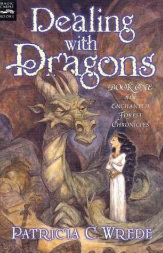 Dealing with Dragons (Enchanted Forest Chronicles - book 1) by Patricia C. WredeMagic Carpet Books (Harcourt), 1990Cimorene is the youngest of the King of Linderwall's seven daughters, and she hates being a princess. In order to avoid royal life and marrying a prince she considers dull, Cimorene volunteers to become a dragon's princess. Although traditionally princes save princesses who have been taken by dragons, Cimorene relishes the relative freedom and becomes caught up in a plot involving wizards, dragons, and a magic stone. Cimorene is a character that might result when the Paper Bag Princess got a little bit older: brave, smart, independent, and with no interest in being rescued by a prince. Cimorene is also perceptive and witty, and I liked her a lot (I imagine it would be quite difficult to dislike Cimorene). I found the vast majority of the characters to be entertaining and consistent, from Alianora to Kazul. Even Moranz was fun. In fact, the my entire experience with Dealing with dragons can be summed up with that word: fun. The plot was suitably thick, the wit was quick, new and unexpected characters were delightful, and I am very much looking forward to reading the rest of the series.
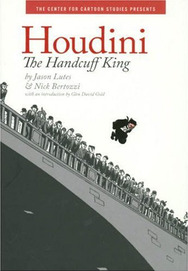 Houdini: the handcuff king by Jason Lutes & Nick BertozziThe Centre for Cartoon Studies, 2007It is 5:00am on May 1, 1908, and Harry Houdini is preparing for a handcuffed jump off of Harvard Bridge in Cambridge, Massachusetts. He checks the police-issued handcuffs, goes for a jog, and reviews the stunt plan with the police and his assistant. With the river almost freezing over and a large crowd expected, Houdini has his livelihood as well as his life at stake. The handcuff king is from the same publisher as my earlier-reviewed Amelia Earhart: this broad ocean, and it bears some striking similarities. Three colours are used in the drawings - in this case black, white, and a grey-blue - and there is a lengthy introduction by Glen David Gold, who wrote a biography about one of Houdini's contemporaries. Also, at the end of the book, there are more than four pages that provide supplementary details about specific panels in the book, from how the locks of the early 20th century worked to promotion and advertising during that time period. In fact, the back matter provides the context needed for this very brief glimpse into Houdini's life. The entire book spans the events of one day , and one stunt, in Houdini's career. It is a snapshot of the man he was, from his adoration of his wife Bess to the control he had over every single aspect of a performance, and an indication of his ability to attract huge crowds to his spectacles. The illustrations were detailed, particularly the crowd scenes, although I found the lettering style distracting. My favourite part of the book was when Houdini is struggling to escape from the handcuffs while underwater, which is shown on the panels at the edge of each page, and the reactions of the crowd and the ticking clock is shown in inner panels. It gives a distinct atmosphere of concurrent events and certainly increased the tension of the moment for me, and I appreciate how the Lutes and Bertozzi take this life-threatening stunt that would be a memorable event in most people's lives, and present it as a common occurrence in Houdini's life. The handcuff king is an accessible introduction to the life of a man that holds mystique for many, and in a format that students will be drawn to and learn from.
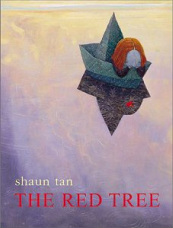 The red tree by Shaun TanSimply Read Books, 2003I unabashedly adore Shaun Tan. It should be noted that this was not the case before I read The red tree. Granted, I think his The arrival is a work of genius, but The red tree spoke to me so vividly that I would probably be struck dumb if ever I was lucky enough to meet him. The premise of The red tree is simple: a young girl wakes up and "...the day begins / with nothing to look forward to / and things go from bad to worse,"* until the end of the day when something remarkable happens. The execution, however, is anything but simple: the illustrations are stunning and the text is spare and poetic. The phrases Tan uses get right to the point, from "nobody understands" to "sometimes you just don't know what you are supposed to do." Hopelessness, fear, and yearning permeate this day in the small girl's life. The illustrations start out simply, with a depiction of the girl getting out of bed taking up about a fifth of the story's initial two-page spread. They do not stay simple however, and scenes straight out of a dark fantasy emerge. From desolate landscapes to massive mechanical dragons and ships in roiling seas, the small protagonist encounters a long sequence of unwelcoming environments. A lone red leaf is with her throughout her day, something that I did not catch until I read the book a second time. Having read two of Shaun Tan's other books - The arrival (2007)and Tales from outer suburbia (2008) - it is fascinating to see how some visual elements from The red tree are also found in those books. For example, one of the earliest scenes in The red tree shows the girl with a large old-fashioned submarine helmet on her head, which is very similar to the helmet found on the cover of an edition of Tales from outer suburbia. While the human characters in The arrival are more realistic in their features, the alien space and objects in The red tree have similarities to the atmosphere in The arrival. This is a book that is, arguably, for older students. While it is as dark as it is beautiful, I would not shy away from having it in an elementary library. However, I believe that older students, especially teens, would get a lot more out of The red tree. As an adolescent I remember often feeling hopeless, misunderstood, and like nothing good would ever happen to me, and anecdotal evidence suggests that many others would agree. The red tree is a beautiful, poignant book that I will purchase for the school libraries I manage, and a thousand thanks to my professor for the recommendation. *Another unpaginated picture book! These lines are the first three lines of the book, but all other quotes in this review will not be given a page reference.
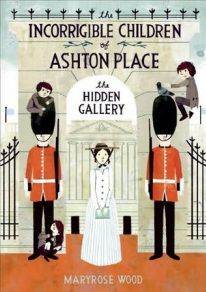 The Hidden Gallery (The Incorrigible children of Ashton Place, book 2) by Maryrose Wood
Balzer + Bray, 2011
Governess Penelope Lumley is off to London with her three pupils - Alexander, Beowulf, and Cassiopeia Incorrigible - and their guardians, Lord and Lady Ashton. Penelope is excited to be able to visit with her beloved former headmistress, Miss Mortimer, and begins planning educational walking tours around the city for herself and the children using the guide Miss Mortimer sent to her. Things begin to go awry as soon as she and the Incorrigibles step off the train, from getting lost to strange proclamations from a fortune teller, but Penelope continues to be optimistic. When a luncheon with Miss Mortimer takes a mysterious turn, Penelope becomes determined to get to the bottom of who may be threatening her beloved Incorrigibles and why they were left in the woods to be raised by wolves in the first place.
The Incorrigible Children of Ashton Place books are spoofs of classic governess novels (such as Jane Eyre) and poke a lot of fun at Victorian life and culture, and this second book in the series certainly delivers on those counts. The fact that the children were actually raised by wolves is a gimmick that is still paying off in The hidden gallery, although I find that the children have stagnated a bit in their development and acculturation. In the first book (which I read a few months ago so have not reviewed here), the children had just been discovered so could not speak human language and were terrified of their new situation. The process of their linguistic and cultural acquisition was handled in a manner that was both charming and hilarious, as were Penelope's reactions to and methods of teaching the children. In this second book, while still charming and often hilarious, the children did not develop very much further. True, they are all clever and learn quickly, whether it's navigation techniques or geometry, but their skills did not seem to improve very significantly. Perhaps it is inevitable that they would not develop as much as during the first book, but more individual character evolution would have been nice to see, as in my mind the three children are almost interchangeable.
This lack of character development does not apply to Penelope, who is earnest and also very clever, if a bit naive. She doesn't shy away from a challenge (if it wasn't already obvious when considering her pupils), even if that challenge is befriending the moody, spoiled Lady Ashton. Indeed, Penelope has the sort of astute intellect that would be a menace if she discovered the powers of sarcasm. The addition of Simon Harley-Dickinson - whose surname I nearly always misread as Harley-Davidson - to the cast of characters was welcome, and I also enjoyed learning more about housekeeper Mrs. Clarke.
There is an entangled mystery to the Incorrigible Children books, and that is why the children were raised by wolves in the first place and what connection Lord Ashton has to them. Penelope is also tied up in all of this as an orphan who has the same hair colour as the Incorrigibles. Now, by the end of the first book it was obvious what was going on with Lord Ashton (I won't ruin it for you though), and by the end of The hidden gallery Penelope seems to have it figured out although it is not spelled out to the reader. True, perhaps Maryrose Wood assumes all the readers know what is going on with Lord Ashton, but it seems drawn out longer than necessary. I worry that, as much as I delight in these books, the mysteries will be drawn out to the point that the books will become episodic. I sincerely hope that does not come to pass.
As soon as I found out that there was a second book about Penelope and the Incorrigibles, I was determined to get my hands on it, and overall this sequel does not disappoint with its pokes at Victorian culture that made me giggle out loud. I am now waiting to get my paws on the third.
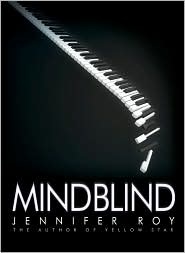 Mindblind by Jennifer RoyMarshall Cavendish, 2010Nathaniel is fourteen years old, enjoys video games and The Amazing Race, and plays keyboards in a band with his best friend and the girl he adores. He is also a homeschooled university graduate, very skilled at mathematics, and has Asperger syndome. Nathaniel's life goal is to be an official genius, which is what many people consider him to be due to his incredible memory and knowledge. However, according to a book he read when he was seven years old, someone must "accomplish something outstanding" (p. 14) before he or she can be considered a genius, so Nathaniel is determined to meet that objective as soon as he can. It remains to be seen if life will get in the way of his goal, and how he might manage to achieve it. Nathaniel has a typically complex teenage life: a girl he secretly has a crush on, divorced parents, not getting along with his father, and an embarrassing episode at a party. On top of that, he struggles to communicate with his family and friends due to his difficulty interpreting social cues, but he is an eminently likable person and quite self-aware. I enjoyed seeing the world from Nathaniel's perspective. The supporting characters have a lot going on as well. Nathaniel's mother was a highlight for me, and her interactions with Nathaniel were kind, firm, and she often exhibited a sense of humour. In many ways, Nathaniel's father is the villain of the book in that he steadfastly refuses to try to relate to Nathaniel in a manner that is outside his comfort zone or expectations. The developing relationships that Nathaniel has with his father's wife and his four-year-old half-brother were lovely to observe, and Nathaniel's best friend Cooper was solid as a rock. So many people in Nathaniel's life were supportive of him and his gradual awareness of this was heartwarming. Author Jennifer Roy has taken her experiences with her son (who, according to her website, also has Asperger syndrome and his highly gifted) and as a teacher and woven them into Mindblind. Thoughtful, humourous, illuminating, and highly recommended.
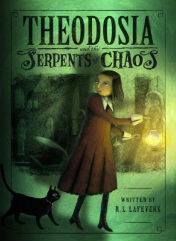 Theodosia and the Serpents of Chaos by R. L. LaFeversHoughton Mifflin, 2007 Theodosia's parents both study ancient Egypt and work for London's Museum of Legends and Antiquities. As a result, eleven-year-old Theodosia spends almost all her time at the museum which is wonderful since she is interested in antiquities, but it's not so great because she can sense the ancient curses that surround many of the Egyptian artifacts. When her mother finds and brings the legendary jeweled Heart of Egypt to the museum, Theodosia is not the only person who knows of its devastating powers, but it appears that she may the only one who can save Britain from the doom to come. What a rip-roaring adventure! It's almost like The Mummy but with children as protagonists (and I mean that in the best possible way: action, adventure, Egyptian curses, chase scenes, but unfortunately for me no Medjai, sigh). Serpents of chaos also involves pickpockets, a stowaway, hidden burial chambers, a demonized cat, and a secret brotherhood. How's that for excitement! Amidst it all, Theodosia as a character is solid as a rock. She is clever, independent, daring, and is rather attached to her cat's presence while she sleeps in an empty sarcophagus most nights (her father is the Head Curator and rarely leaves his place of work while his wife is away on a dig). She also realizes that her ability to sense curses makes her different from her parents, and as a result she is essentially an expert in neutralizing Egyptian curses due to her extensive studies while she is stuck at the museum. The adults who surround her on a daily basis fail to recognize her knowledge, which causes Theodosia much frustration. This frustration drives many of her actions throughout the book, and she is determined to prove to her parents that she is of great worth. The historical setting is an interesting one. The events occur in what seems to be early 1914, and the author does a stand-up job of simply explaining the complicated international relations that existed at that time and which provide a backdrop to the significance of the Heart of Egypt. I'm curious to read the sequels to Theodosia and the Serpents of Chaos for many reasons, but one of the main ones is to find out how the advent of the First World War will be incorporated into the plot if, indeed, it is. This is a novel that should appeal to boys and girls with its wit, adventure, and magic, and will likely spur interest in ancient Egypt as well.
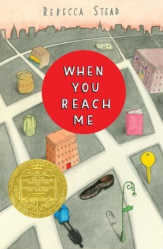 When you reach me by Rebecca Stead
Wendy Lamb Books (Random House), 2009
It's 1978 and Miranda is in sixth grade in New York City. She and her best friend Sal are drifting apart, and mysterious letters keep appearing which are addressed to her and accurately predict the future. Miranda doesn't know what to make of the notes and the events they describe, but her absolute favourite book - A wrinkle in time by Madeleine L'Engle - may turn out to be the key to the mystery.
There is so much going on in this brief (197-page) novel that it would take another few paragraphs to write a synopsis that covers the key plot points. I do not say this disparagingly in the least, as the author handled the story's complexities extraordinarily deftly and, for the most part, linearly. It is quite a feat, as is the fact that I hadn't the slightest clue who the mysterious letter-writer was until it was revealed. In fact, it is a book I intend to re-read in order to discover what I missed the first time.
The characters are what made this book a joy for me to read. Miranda is intelligent, perceptive, and valiantly trying to make some sense of the world around her. I appreciated the little details about her inner life, such as how she balances her fears with her realism by approaching people she's afraid of to ask the time so she can see that they are, in fact, not so scary. Also, she is aware of the little moments of poetry in daily life while not noticing that a close friend eats a special diet, which is that odd mix of worldliness and obliviousness that can be found in many 11-year-olds.
When you reach me is, at its essence, about the interactions between people in Miranda's world: Miranda's relationships with her mother and her mother's boyfriend, sixth-grade friendships that form almost as mysteriously as they end, and Miranda's observations of the people within her neighbourhood. The characters are lively and real and had their own things going on outside the walls of the story, especially Marcus and Julia. There always seemed to be a lot going on for Miranda, even if big events didn't happen very often. And if that isn't an accurate depiction of real life, then I'm not sure what is.
When you reach me is the Newbery-winning novel of 2010 and rightly so.
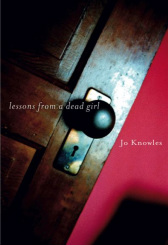 Lessons from a dead girl by Jo Knowles
Candlewick, 2007
Beautiful, popular Leah takes awkward Laine under her wing when they are in fifth grade and declares them to be friends forever. Laine is confused by the attention but happily goes along with it. Laine even goes along with Leah's insistence that they secretly "practice" for marriage together, although Laine becomes increasingly confused by what it means about her relationship with Leah. While the girls grow apart as they enter high school, Leah maintains a powerful hold over Laine until a public confrontation results in tragedy.
Knowles tackles the topic of sexual abuse between children head-on, and she does it with a remarkably delicate touch while pulling no punches. Laine's confusion and desperation to keep Leah happy, as well as the tension between Laine and Leah in the years after their "practice" ends, are well-rendered. Although there are certainly scenes that are uncomfortable as a reader, nothing is graphically presented and the narrative focuses primarily on the emotions of the characters, especially Laine as the novel is from her point of view.
Leah and Laine are three-dimensional characters with specific and evident motivations, and their respective evolutions as they grow into teenagers are unsurprising but nonetheless poignant. Although I know very little about this topic, it would appear that the author did a good deal of research to create such believable characters, and this novel was an emotional and educational introduction to the subject and will not soon be forgotten.
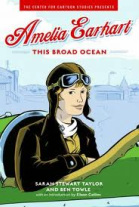 Amelia Earhart: this broad ocean, written by Sarah Stewart Taylor and James Sturm, illustrated by Ben Towle
Hyperion Books, 2010
Amelia Earhart departed on her historic 1928 voyage across the Atlantic from the small Newfoundland port town of Trepassey. After several days of false starts due to weather and other complications, Earhart became the first woman to fly across the Atlantic Ocean. This graphic novel tells Earhart's story - and her influence - through the eyes of Grace, a curious young girl of Trepassey.
The framing of this story works very well: Grace is intent on being a reporter (even among the real newspaper reporters sent to Trepassey from around North America) which reflects Amelia Earhart's determination to be the first woman to fly across the Atlantic, and I found myself wanting to see them both succeed. In fact, I was hoping that Grace and Earhart shared a second characteristic and that they were both real historical figures. Alas, there is no indication in the supporting information that Grace was a real person.
This broad ocean has a distinctive visual style with the use of only black, white, and a light turquoise colour in the illustrations. The drawings are simple in both their lack of colours and the lines used, but movement is well indicated. I am not sure if it was intentional, but Grace and Earhart bear a striking physical resemblance to one another with freckles and short, fly-away hair (truly, they have the same haircut except that Grace's is a touch longer), which undoubtedly contributed to my impression that Grace is the reflection of a young Earhart.
Despite some fictionalization in this graphic novel, there is quite a bit of supplementary information to the main text of the book for those who are curious to know more. Over four pages of discussion about individual illustrated panels found in the book are at the back, as well as a bibliography and selected reading list. The introduction by Eileen Collins, the first woman to pilot a space shuttle, is a personal testament to Earhart's impact in her own life and achievements.
Ultimately, this is a great introduction to Amelia Earhart's life and influence in a format that is popular with young students.
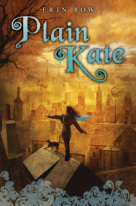 Plain Kate by Erin BowArthur A. Levine Books (Scholastic), 2010Let me start at the end: I was reduced to not a slightly teary, not a delicately weepy, but a blubbering, sobbing mess at the end of this book. I haven't cried so much because of a book since I struggled to read the last chapters of Tolkien's The Return of the King through a veil of tears, a comparison which may give you an indication of both how invested I was in the characters and the effectiveness of Bow's world-building. Bow's prose certainly reflects the fact that she is a published poet, with phrases like "the sky had slid shut under a lid of low clouds" (p. 30) appearing throughout. This lyricism lent itself well to the dark, magical world that Plain Kate inhabits and tries her best to make her way safely through. The book is very atmospheric, and I could almost feel the cold damp of the fog traveling upriver, or hear the mud pulling at the bottom of Plain Kate's boots. The novel has a distinct Medieval, Eastern European feel to it, with towns and cities located at great distances from one another and tinkers and merchants selling their wares in outdoor markets.Plain Kate is an evocative main character. She reveals herself slowly to other characters as well as to the reader, and coming to know her gradually made her feel all the more real. Her constant companion, Taggle the cat, is a wonderful comic foil to Plain Kate's seriousness while remaining an exceedingly loyal companion (despite his derision for dogs). Secondary characters, such as Drina and Behjet, are three-dimensional with their own tangled beliefs and personal sorrows that are hinted at and not always explained, leaving the reader to draw their own conclusions. As in reality, people and events were not always tied up neatly, which makes it easier to believe that the world in Plain Kate has no boundaries and continues to exist. Although it took me a few dozen pages to get truly sucked into Plain Kate, once I was in it I wasn't prepared to leave until I got to the end. Had someone asked me after the first chapter if I would be an emotional wreck at the end of the book, I would have given a definitive no. I am exceedingly glad that I would have been wrong, and I will be recommending this book to many. Edited February 15th to add: I just found a fantastic book trailer for Plain Kate made by Scholastic:
|










 RSS Feed
RSS Feed